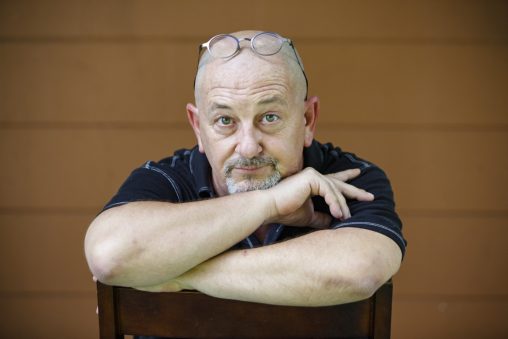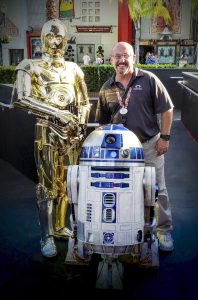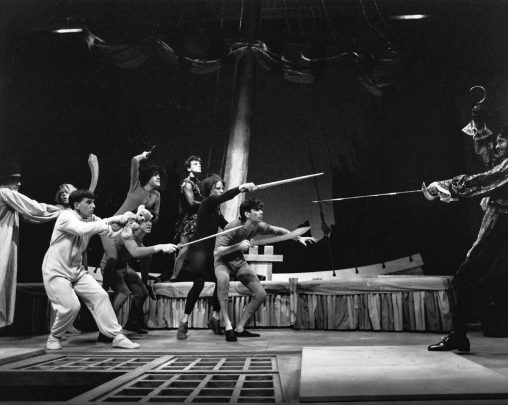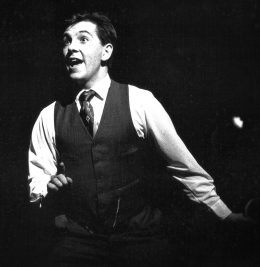
Wright State acting alumnus Jake Lockwood develops unique and interactive entertainment experiences for Disney audiences. (Photo credit: James Berkley)
As an acting major at Wright State University in the late 1980s and early 1990s, Jake Lockwood hated improv classes.
“Everything I had done was script work. You take a script and you learn your lines. This idea of making it up as you go along was bananas,” Lockwood recalled thinking. “I really resisted it.”
Years later, as a performer at Walt Disney World in Orlando, Florida, Lockwood would discover that improv was not only fun, but also a wonderful stepping stone to a career as a show writer and director.
“A lot of what I’ve done as a director is taking those improv tools and training and weaving them into this immersive theatre that is coming of age,” said Lockwood.
As an independent contractor and through We Bring The Funny—a company he co-owns with two friends—Lockwood is putting his stamp on developing unique and interactive entertainment experiences for audiences, whether they’re cruising along the shore of Alaska, visiting a theme park, or attending a trade show.
One of Lockwood’s most recent creative ventures involves working with the global experience and innovation team at Princess Cruises. While he couldn’t share specific details about the project, Lockwood did say they are examining the fleet at large and developing programs and initiatives that will challenge the status quo and shape the cruise industry going forward.
“We’re looking at everything,” he said. “What does the restaurant feel like? What does your welcome aboard feel like? Does the entertainment on your stateroom TV enhance your overall cruise experience?”
Through his work with Disney, Lockwood has become seasoned at elevating the guest experience to new heights. He spent three years partnering with the team at Walt Disney Imagineering on the development of Star Wars: Galactic Starcruiser, the newest hotel on Disney property that immerses guests into the world of Star Wars for a two-night adventure.
The storytelling journey begins as soon as guests board the Galactic Starcruiser, where they are sent on missions and launched into a wide variety of interactions with characters from the Star Wars franchise.
“You have the same characters that you’re playing with for two days. It becomes a whole relationship,” Lockwood explained. “It was really fun to play with and help direct that development process.”
Lockwood first worked with the team at Disney Imagineering in 2015, when he was a show director on Star Wars Weekends at Disney’s Hollywood Studios.
“Every weekend, we would bring in different celebrities from the Star Wars movies and TV shows,” he said. “We would have different offerings every week, so people would come back time and time again to see the parades and the shows that we would put on.”
As part of the Star Wars Weekends, Disney Imagineering wanted to test new ways in which guests could interact with the characters. In lieu of the traditional meet and greet, where guests stand in line waiting to get their photo taken with a character, Lockwood was tasked with creating innovative experiences where guests could actually interplay with both beloved and reviled characters.
“It was wildly successful,” he said. “I would see parents taking pictures of kids hiding behind crates with Ezra and Sabine from Star Wars Rebels as opposed to standing and holding their hands. You got this great action shot of them hiding from Stormtroopers. As a parent, that’s the picture I want to put on Facebook and in the memory book.”

Lockwood with two of his favorite droids, C3PO and R2D2, during “Star Wars” Weekends 2015 at Disney’s Hollywood Studios.
Lockwood’s relationship with Disney first began in the early 1990s when Lockwood was an acting major at Wright State. Two of his friends were traveling to Chicago to audition for Disney, and they convinced Lockwood to go with them.
By 9:30 that morning, Lockwood’s two friends had been cut from the audition. Meanwhile, Lockwood kept advancing through the process. By 5 p.m., he was being measured for costumes.
“I suddenly realized that my life had just changed,” he recalled.
Lockwood originally envisioned that he would perform at Disney World for two years, pay off his college loans, then pursue acting jobs in New York City or Los Angeles. But Disney was an equity job. It paid well and there were opportunities to grow.
Lockwood spent the next 15 years as a full-time performer at Disney World. One of the highlights of his Disney tenure was performing in The Comedy Warehouse, an improv show in the entertainment district formerly known as Downtown Disney. The Comedy Warehouse troupe performed five shows a night, seven nights a week.
“It was challenging and creatively rewarding,” said Lockwood. “The core team got really close to each other. We knew each other so well. We were a really tight improv troupe that was able to deliver on the Disney standard.”
Lockwood found his writer’s voice during those years, as he took suggestions from the audience and turned them into comedy sketches and songs on the spot.
“I credit Comedy Warehouse with my success in my career,” he said.
As The Comedy Warehouse was coming to a close, Lockwood and his wife returned to Dayton for a few years. During that time, he performed in several shows at the Human Race Theatre Company, where he is now a resident artist.
“Human Race will always be in my heart. I’ll always try to find opportunities to either perform or support them in their mission,” said Lockwood.
In August 2022, Lockwood was one of the writers and directors for Human Race’s first Playwright Race, part of the Art in the City celebrations in downtown Dayton. Writers, directors, and actors had less than 24 hours to write, rehearse, and perform five-minute scenes in pop-up performances throughout the festival.
Lockwood’s experience with Disney helped open the door to his work with youth theatre groups. He previously spent two years as senior show director at Vandalia Youth Theatre. One of his fondest memories of that time was spearheading a stage version of The Hunchback of Notre Dame. That production is especially meaningful to Lockwood, since he had opened the Disney theme park version of the show on the same day the movie premiered in theaters in 1996.
“To be able to do it again on stage with a huge cast was so rewarding,” he recalled. “I love working with youth. They’re like sponges and you get such great discoveries out of them when you set them free as artists.”
Lockwood first caught the acting bug as a young child, when he began performing on stage at age 3. Even though he grew up in the world of theatre, he resisted doing it in high school, because theatre wasn’t considered cool. He focused his attention on band and even thought about becoming a band director.
A friend—who had been accepted to Wright State—convinced Lockwood that acting was his true calling and encouraged him to audition for Wright State’s theatre program. Lockwood was accepted into the selective program and decided to try Wright State for a year to see if he liked it.
“I immediately fell in love with everything that was happening at Wright State,” said Lockwood, who joined the National Guard to earn money for his tuition. “I wouldn’t trade my Wright State experience for the world.”
Lockwood has remained close to his Wright State family. A few years ago, he helped organize a reunion for alumni of the theatre, dance, and motion pictures programs. He also spent three years as an adjunct faculty member, teaching improv to sophomore acting majors at Wright State.
“I was thrilled to be able to share what I know and to see the lights go on for my students,” he said. “I loved that experience. I learned as much as I taught.”
While he spends most of his time in the Orlando area, Lockwood still has much love for Dayton and his college alma mater.
“What a great program. You look at some of the successes who have come out of Wright State and continue to come out of Wright State, and I am just so immensely proud to be a part of that family,” he said.
Lockwood continues to stay busy, working on projects that unleash his creativity and challenge the norm. He is currently in the process of writing several plays.
“Keep an eye out,” he said. “You never know where you’ll see my name next.”
This article was originally published in the spring 2023 issue of the Wright State Magazine. Read more stories at wright.edu/magazine.




 Milling around
Milling around  Wright State recognizes Nursing Professor Kim Ringo for advancing international student success
Wright State recognizes Nursing Professor Kim Ringo for advancing international student success  Wright State honors graduating students for distinguished doctoral dissertations
Wright State honors graduating students for distinguished doctoral dissertations  Top 10 Newsroom videos of 2025
Top 10 Newsroom videos of 2025  Museum-quality replica of historic Hawthorn Hill donated to Wright State
Museum-quality replica of historic Hawthorn Hill donated to Wright State 